Results
Puzzle opening task success
Only five (Red Junglefowl - RJF n = 2; White Leghorn - WL n = 3) out of 53 sampled birds over both treatment groups opened the puzzle completely with an average of 58.8 pecks required to do so. The average time taken to open the puzzle was 117.4 s. A total of 17 individuals (RJF n = 10, WL n = 7) moved the puzzle lid at least partially (see figure below). Guided RJF were significantly more likely to move or open the lid when compared to naïve RJF.
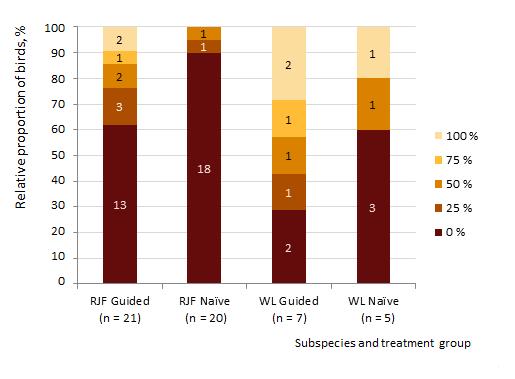
The furthest lid position achieved during the test in each treatment group and subspecies. Data is displayed in relative proportions, as group sizes differed from one another. Numbers inside the bars represent the number of individuals in that category. 0 % ‒ the lid was not moved, 25 % ‒ the lid was moved slightly, but its edge does not reach the edge of the food dish, 50 % ‒ the edge of the lid aligns with the edge of the food dish, 75 % ‒ the lid reveals a portion of the food dish, 100 % ‒ the lid reveals the food dish completely or enough to access the food inside.
Behaviours directed at the puzzle apparatus
Pecks
There were significant effects of both subspecies and treatment group on the number of pecks directed at the puzzle (see figure below). Guided birds pecked at the puzzle significantly more than naïve ones. WLs pecked at the puzzle significantly more than RJF. The number of pecks significantly positively correlated with a further puzzle lid position only in the guided RJF group.
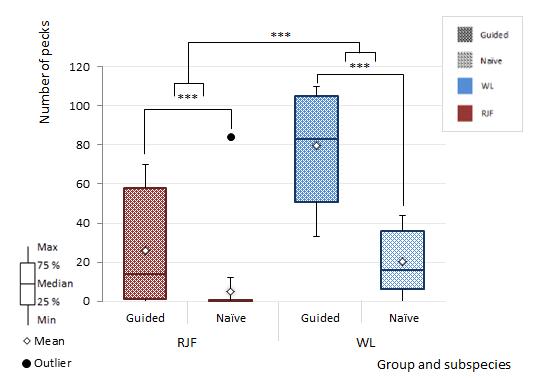
The number of pecks directed at the puzzle by red junglefowl (RJF) and white leghorns (WL) in each treatment group. *** indicates statistically significant differences at p < 0.001.
Approaches
The differences in the number of approaches followed similar trends to the previously described number of pecks, but on a less extreme level. Guided groups approached the puzzle significantly more times than naïve birds. WLs approached the puzzle significantly more than RJF.
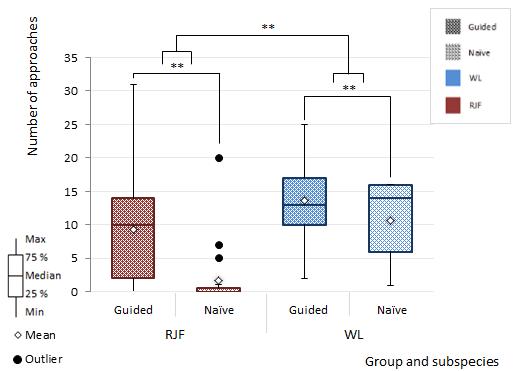
The number of times red junglefowl (RJF) and white leghorns (WL) from both treatment groups approached the puzzle (5 cm distance threshold). ** indicates statistically significant differences at p < 0.01.
General activity (one-zero sampling)
All except two of the general activity behaviours were similar across subspecies and treatment groups. These two exceptions were interactions with the puzzle apparatus and feeding from the metal feeder.
Interacting with the puzzle apparatus
Birds in the guided groups spent significantly more time interacting with the puzzle apparatus, than those in naïve groups (see figure below). In both treatments, WLs would interact with the puzzle apparatus significantly more than RJF.
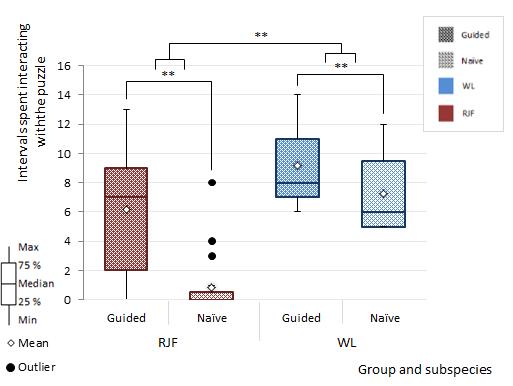
The number of 1 min intervals during which red junglefowl (RJF) and white leghorns (WL) of both treatment groups interacted (approached or pecked) with the puzzle apparatus. ** indicates statistically significant differences at p < 0.01.
Feeding (from the metal feeder)
Guided birds spent significantly more time feeding from the feeder than naïve birds (see figure below). Subspecies did not have a significant effect on time spent feeding, however.
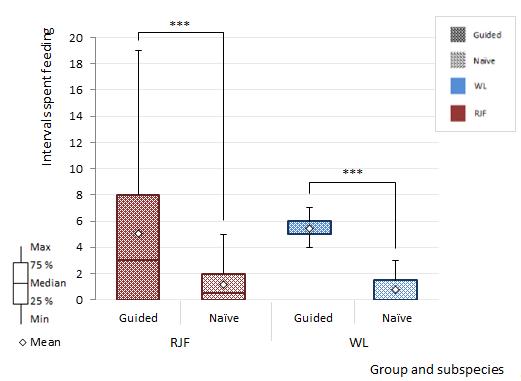
The number of 1 min intervals during which red junglefowl (RJF) and white leghorns (WL) of both treatment groups fed from the feeder. *** indicates statistically significant differences at p < 0.001.
A more detailed version of the results, including the exact statistical tests used, their output and p values, can be found in the full thesis document. It is available for download on my starting page (click on my name on the menu to return to the starting page).
Responsible for this page:
Director of undergraduate studies Biology
Last updated:
05/11/21
